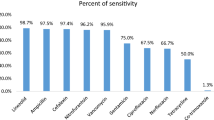Abstract
The main drawback of current antibiotic therapies is the emergence and rapid increase in antibiotic resistance. Nocardiae are aerobic, Gram-positive, catalase-positive, non-motile actinomycetes. Nocardia brasiliensis was reported as antibiotic producer. The purpose of the study was to determine antibacterial activity of N. brasiliensis PTCC 1422 against isolated Enterobacteriaceae from urinary tract infections (UTIs). The common bacteria from UTIs were isolated from hospital samples. Antimicrobial susceptibility test was performed for the isolated pathogens using Kirby–Bauer disk diffusion method according to clinical and Laboratory Standards Institute guideline. Antagonistic activity of N. brasiliensis PTCC 1422 was examined with well diffusion methods. Supernatant of N. brasiliensis PTCC 1422 by submerged culture was analyzed with gas chromatography–mass spectrometry. Isolated strains included Escherichia coli, Klebsiella pneumoniae, Serratia marcescens and Proteus mirabilis. The most common pathogen isolated was E. coli (72.5 %). Bacterial isolates revealed the presence of high levels of antimicrobial resistances to ceftriaxone and low levels of resistance to cephalexin. Supernatant of N. brasiliensis PTCC 1422 showed antibacterial activity against all of the isolated microorganisms in well diffusion method. The antibiotic resistance among the uropathogens is an evolving process, so a routine surveillance to monitor the etiologic agents of UTI and the resistance pattern should be carried out timely to choose the most effective empirical treatment by the physicians. Our present investigation indicates that the substances present in the N. brasiliensis PTCC 1422 could be used to inhibit the growth of human pathogen. Antibacterial resistance among bacterial uropathogen is an evolving process. Therefore, in the field on the need of re-evaluation of empirical treatment of UTIs, our present. The study has demonstrated that N. brasiliensis PTCC 1422 has a high potential for the treatment of UTIs.



Similar content being viewed by others
References
Annadurai G (2000) Design of optimum response surface experiments for adsorption of direct dye on chitosan. Bioprocess Eng 23(5):451–455
Colodner R, Rock W, Chazan B, Keller N, Guy N, Sakran W, Raz R (2004) Risk factors for the development of extended-spectrum beta-lactamase-producing bacteria in nonhospitalized patients. Eur J Clin Microbiol Infect Dis 23(3):163–167
El-Helow E, Sabry S, Amer R (2000) Cadmium biosorption by a cadmium resistant strain of Bacillus thuringiensis: regulation and optimization of cell surface affinity for metal cations. Biometals 13(4):273–280
Karatzas KA, Webber MA, Jorgensen F, Woodward MJ, Piddock LJ, Humphrey TJ (2007) Prolonged treatment of Salmonella enterica serovar Typhimurium with commercial disinfectants selects for multiple antibiotic resistance, increased efflux and reduced invasiveness. J Antimicrob Chemother 60(5):947–955
Khucharoenphaisan K, Sripairoj N, Sinma K (2012) Isolation and identification of actinomycetes from termite’s gut against human pathogen. Asian J Anim Vet Adv 7:68–73
Komatsu K, Tsuda M, Shiro M, Tanaka Y, Mikami Y, Kobayashi JI (2004) Brasilicardins B–D, new tricyclic terpernoids from actinomycete Nocardia brasiliensis. Bioorg Med Chem 12(21):5545–5551
Ligor M, Buszewski B (2006) An investigation of the formation of taste and odour contaminants in surface water using the headspace SPME-GC/MS method. Pol J Environ Stud 15(3):429–435
Maharjan S, Koju D, Lee HC, Yoo JC, Sohng JK (2012) Metabolic engineering of Nocardia sp. CS682 for enhanced production of nargenicin A1. Appl Biochem Biotechnol 166(3):805–817
Mikami Y, Yazawa K, Nemoto A, Komaki H, Tanaka Y, Graefe U (1999) Production of erythromycin E by pathogenic Nocardia brasiliensis. J Antibiot 52(2):201–202
Mitra A, Santra SC, Mukherjee J (2008) Distribution of actinomycetes, their antagonistic behaviour and the physico-chemical characteristics of the world’s largest tidal mangrove forest. Appl Microbiol Biotechnol 80(4):685–695
Mukai A, Fukai T, Matsumoto Y, Ishikawa J, Hoshino Y, Yazawa K, Mikami Y (2006) Transvalencin Z, a new antimicrobial compound with salicylic acid residue from Nocardia transvalensis IFM 10065. J Antibiot 59(6):366–369
Noor N, Ajaz M, Rasool SA, Pirzada ZA (2004) Urinary tract infections associated with multidrug resistant enteric bacilli: characterization and genetical studies. Pak J Pharm Sci 17(2):115–123
Pitout JD (2010) Infections with extended-spectrum β-lactamase-producing Enterobacteriaceae. Drugs 70(3):313–333
Pitout JD, Nordmann P, Laupland KB, Poirel L (2005) Emergence of Enterobacteriaceae producing extended-spectrum β-lactamases (ESBLs) in the community. J Antimicrob Chemother 56(1):52–59
Rakshanya U, Shenpagam H, Devi DK (2011) Antagonistic activity of actinomycetes isolates against human pathogen. J. Microbiol Biotech Res 1(2):74–79
Rodríguez-Baño J, Alcalá JC, Cisneros JM, Grill F, Oliver A, Horcajada JP et al (2008) Community infections caused by extended-spectrum β-lactamase-producing Escherichia coli. Arch Intern Med 168(17):1897–1902
Singh N, Rai V (2013) In vitro antimycotic activity of a new isolate Streptomyces fradiae MTCC 11051 against the multi-drug resistant pathogenic fungi. J Pharm Res 7(4):331–336
Srifuengfung S, Poonwan N, Tribuddharat C, Chokephaibulkit K (2007) Prevalence of nocardia species isolated from patients with respiratory tract infections at Siriraj Hospital, Thailand. J Infect Dis Antimicrob Agents 24:1–6
Verma VC, Gond SK, Kumar A, Mishra A, Kharwar RN, Gange AC (2009) Endophytic actinomycetes from Azadirachta indica A. Juss.: isolation, diversity, and anti-microbial activity. Microb Ecol 57(4):749–756
Vimal V, Rajan BM, Kannabiran K (2009) Antimicrobial activity of marine actinomycete, Nocardiopsis sp. VITSVK 5 (FJ973467). Asian J Med Sci 1(2):57–63
Acknowledgments
This study was supported by Department of Microbiology, Faculty of Sciences, Lahijan Branch, Islamic Azad University, Lahijan, Iran.
Author information
Authors and Affiliations
Corresponding author
Ethics declarations
Conflict of interest
Hossnieh Kafshdar Jalali, Abdolreza Salamatzadeh, Arezou Kafshdar Jalali, Hamed Haddad Kashani, Salman Ahmadi Asbchin and Khosro Issazadeh declare that they have no conflict of interest.
Ethical Approval
This article does not contain any studies with human participants or animals performed by any of the authors.
Rights and permissions
About this article
Cite this article
Jalali, H.K., Salamatzadeh, A., Jalali, A.K. et al. Antagonistic Activity of Nocardia brasiliensis PTCC 1422 Against Isolated Enterobacteriaceae from Urinary Tract Infections. Probiotics & Antimicro. Prot. 8, 41–45 (2016). https://doi.org/10.1007/s12602-016-9207-0
Published:
Issue Date:
DOI: https://doi.org/10.1007/s12602-016-9207-0




